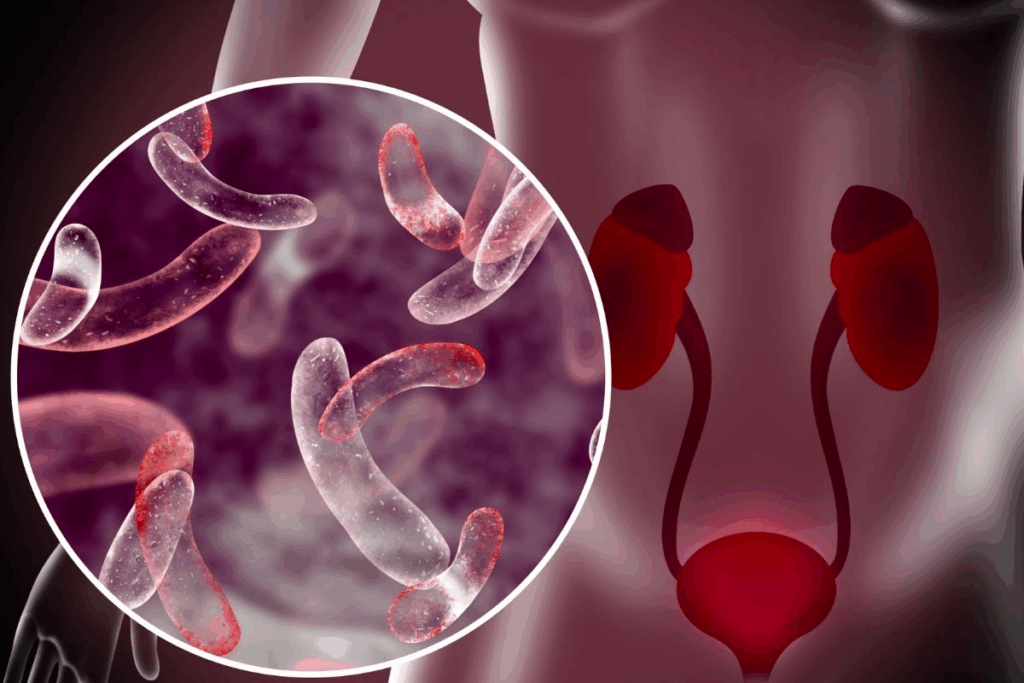
At Liv Hospital, we understand the big challenge of bacterial pharyngitis. It’s mainly caused by Group A beta-hemolytic streptococcus (GABHS). This condition affects 5-15% of adults and 15-35% of kids in the U.S., as the CDC reports.
A clinical guide on how to treat bacterial pharyngitis (e.g., Strep throat) using antibiotics to prevent complications.
It’s very important to diagnose and treat streptococcal pharyngitis right. This helps avoid serious problems like rheumatic fever. Our team uses the latest tests and treatments to help patients fast and effectively.
Knowing how bacterial pharyngitis works is essential for treating it well. We’ll show doctors the best ways to treat bacterial pharyngitis.

It’s key to know how bacterial pharyngitis spreads to fight it better. This illness causes throat pain, fever, and headaches. It also leads to chills and trouble swallowing.
Research shows that strep throat is more common in kids than in adults. This is why kids need special care to prevent it.
In children, strep throat can cause ear infections and sinus problems. For adults, it can lead to serious health issues and lost work time.
Bacterial pharyngitis affects many people worldwide, mostly in crowded areas with poor healthcare. The World Health Organization wants better ways to handle this disease.
“The burden of bacterial pharyngitis is considerable, with significant implications for healthcare systems and economies worldwide.”
The cost of treating bacterial pharyngitis is high. It includes healthcare costs, lost work time, and the cost of medicines. We need to study these costs to make better healthcare plans.
Category | Cost Components | Estimated Annual Cost |
Healthcare Utilization | Physician visits, diagnostic tests, antimicrobial therapy | $1.2 billion |
Lost Productivity | Missed workdays, reduced productivity | $2.5 billion |
Total Economic Impact | $3.7 billion |
By learning more about bacterial pharyngitis, we can find ways to lessen its effects. This will help improve health outcomes for everyone.

To manage streptococcal pharyngitis well, we need to know how it works. This knowledge helps us diagnose and treat it right.
Group A Beta-Hemolytic Streptococcus (GABHS) is the main cause of streptococcal pharyngitis. It’s a gram-positive bacterium that lives in the throat. It can cause infection with its virulence factors.
The M protein helps GABHS avoid the immune system. It stops the body from attacking it. Other factors like streptolysins and pyrogenic exotoxins cause symptoms like those in scarlet fever.
While GABHS is the main cause, other bacteria can also cause pharyngitis. These include Group C and G beta-hemolytic streptococci, Arcanobacterium haemolyticum, and Fusobacterium necrophorum.
Bacterial Pathogen | Characteristics | Clinical Significance |
GABHS | Gram-positive, beta-hemolytic | Primary cause of streptococcal pharyngitis |
Group C/G streptococci | Gram-positive, beta-hemolytic | Can cause pharyngitis, less common than GABHS |
Arcanobacterium haemolyticum | Gram-positive, hemolytic | Associated with pharyngitis and skin infections |
Streptococcal pharyngitis spreads mainly through respiratory tract secretions. It takes about 2 to 5 days to show symptoms. During this time, the person can spread the infection without showing signs.
The body fights GABHS infection with innate and adaptive immunity. The innate response includes barriers and cells like neutrophils. The adaptive response makes antibodies against GABHS.
Knowing how the body responds is key to treating the infection and preventing complications.
Bacterial pharyngitis shows clear symptoms that doctors need to spot to treat it right. It causes throat pain, fever, headaches, chills, and trouble swallowing.
People with bacterial pharyngitis have a mix of symptoms. The main ones are:
These symptoms can differ in how bad they are and what they are mixed with. But they are key to spotting bacterial pharyngitis.
Doctors find certain signs when they check patients with bacterial pharyngitis. Common signs include:
These signs are important for diagnosing bacterial pharyngitis and telling it apart from other sore throats.
Bacterial pharyngitis shows different symptoms in different ages. Kids often have more severe symptoms like high fever and belly pain. Adults tend to have symptoms that are more focused on the throat. Knowing these age-specific signs is key for correct diagnosis and treatment.
Doctors can better diagnose and treat bacterial pharyngitis by knowing the main symptoms, physical signs, and age-specific signs.
To diagnose bacterial pharyngitis, doctors use a mix of clinical checks and lab tests. They look at many factors to make the right diagnosis and treatment plan.
Clinical prediction rules help doctors figure out if someone has bacterial pharyngitis. The Centor criteria are often used. They include:
These rules help doctors guess if someone has Group A Streptococcal (GAS) infection. This guides further tests and treatment.
Lab tests are key to confirming bacterial pharyngitis. The main tests are:
RADT gives quick results and is very specific. But, its accuracy can vary. Throat culture is more accurate but takes longer.
Test | Sensitivity | Specificity | Turnaround Time |
RADT | Moderate | High | Minutes |
Throat Culture | High | High | 24-48 hours |
When diagnosing bacterial pharyngitis, doctors also consider other causes like viral infections. A detailed check-up and lab tests help tell these apart.
By using clinical rules and lab tests together, doctors can accurately diagnose bacterial pharyngitis. This allows them to start the right treatment.
Effective treatment of bacterial pharyngitis starts with the right antibiotic. We will cover the main steps in treating this condition.
For bacterial pharyngitis, doctors often choose penicillin or amoxicillin. Penicillin or amoxicillin is the antibiotic of choice because they work well and are safe.
If a patient can’t take penicillin, other options like cephalosporins or clindamycin are considered. The right antibiotic depends on local resistance and the patient’s health.
The usual treatment time for bacterial pharyngitis is 10 days. This is key to getting rid of the infection and avoiding problems. It’s important to finish the treatment, even if you feel better sooner.
Along with antibiotics, supportive care helps manage symptoms. This includes:
It’s important to watch how the patient is doing. Improvement usually shows in 48-72 hours after starting antibiotics. If symptoms don’t get better or get worse, it might mean the treatment needs to change.
Special groups, like those allergic to penicillin, need special care for throat infections. They require unique treatment plans to manage bacterial throat infections well.
Patients allergic to penicillin need different antibiotics. Cephalexin, azithromycin, clarithromycin, and clindamycin are good options. The right choice depends on the allergy severity, local resistance, and the patient’s needs.
Antibiotic | Dosing | Duration |
Cephalexin | 500 mg twice daily | 10 days |
Azithromycin | 500 mg on day 1, then 250 mg daily | 5 days |
Clarithromycin | 250 mg twice daily | 10 days |
Clindamycin | 300 mg four times daily | 10 days |
For kids, the antibiotic choice depends on their age, weight, and ability to swallow pills. Younger kids might need liquid forms. Azithromycin and clarithromycin are good because they’re easy to take and have good dosing.
People with weakened immune systems might need stronger or longer antibiotic treatments. Clindamycin or cephalosporins could be options. It’s important to consider their immune status and any drug interactions.
When pregnant or breastfeeding, choosing antibiotics is critical. Penicillin and cephalosporins are usually safe. Azithromycin might be used when needed. Always weigh the benefits and risks.
Healthcare providers can manage bacterial throat infections in special groups by using these alternative strategies. This ensures the best care for these patients.
Treatment failures and recurrent infections in bacterial pharyngitis are big concerns. About 10% of patients face these issues, showing the need for good management plans.
Treatment failure in bacterial pharyngitis means symptoms don’t go away or come back a few days after antibiotics. We look at both clinical and microbiological signs to judge failure.
Clinical indicators of treatment failure include:
Antibiotic resistance makes treating bacterial pharyngitis harder. Knowing local resistance patterns helps us choose the right treatment.
Antibiotic | Resistance Rate | Clinical Implication |
Penicillin | Low | Remains a first-line treatment option |
Macrolides | Moderate | Use with caution; consider susceptibility testing |
Fluoroquinolones | Variable | Reserved for complicated cases or specific resistance patterns |
When first-line treatments don’t work, we look at other antibiotics. Options include:
Some people stay colonized with Group A Streptococcus after an infection. This makes management tricky. We must think about the pros and cons of treating carriers.
Considerations for managing carriers include:
Understanding treatment failures and recurrent infections helps us improve patient care. We can develop better strategies to help more people.
Complications from bacterial pharyngitis can be divided into two types: suppurative and non-suppurative. Knowing about these complications is key to managing and preventing them.
Suppurative complications happen when the infection spreads to nearby areas. This can lead to serious conditions. These include:
Suppurative Complications of Bacterial Pharyngitis
Complication | Description | Management |
Cervical lymphadenitis | Infection of the lymph nodes in the neck | Antibiotics, possible drainage |
Mastoiditis | Infection of the mastoid process | Intravenous antibiotics, possible surgical intervention |
Peritonsillar abscess | Abscess formation around the tonsils | Drainage, antibiotics |
Retropharyngeal abscess | Abscess formation in the tissues behind the pharynx | Drainage, intravenous antibiotics |
Non-suppurative sequelae are immune-related issues that can arise after bacterial pharyngitis. These are often caused by Group A beta-hemolytic streptococcus (GABHS). These include:
To prevent complications from bacterial pharyngitis, it’s important to act fast and treat correctly. We suggest:
By understanding the complications and using preventive measures, we can greatly improve patient outcomes.
Managing bacterial pharyngitis well means using a complete plan. This includes getting the right diagnosis and treatment. It also means stopping the spread of the infection.
This guide has shown how key a good diagnosis is. We talked about using rules and tests to find the cause. We also looked at different treatments and how to care for special cases.
By using a full approach to treat bacterial pharyngitis, we can help patients get better faster. We aim to give doctors the tools they need. This way, we can improve life for those with this illness.
Bacterial pharyngitis is an infection of the pharynx caused by bacteria. Group A Beta-Hemolytic Streptococcus (GABHS) is the most common cause.
Symptoms include a sore throat, fever, swollen lymph nodes, and white patches on the tonsils. You might also have a headache, nausea, and stomach pain.
Doctors use a combination of clinical evaluation and lab tests to diagnose it. These include rapid antigen detection tests and throat cultures. Clinical prediction rules also help.
The first treatment is antibiotics. Penicillin or amoxicillin are usually the first choice for those not allergic to penicillin.
Treatment lasts about 10 days. Some studies suggest shorter courses might work in certain cases.
Untreated or recurrent cases can lead to serious complications. These include peritonsillar abscess and acute rheumatic fever.
Preventive measures include good hygiene and avoiding close contact with sick people. Also, finish all antibiotics as directed.
For those allergic to penicillin, azithromycin, clarithromycin, or clindamycin can be used instead.
It affects all ages, but children and teens are more commonly affected. The impact and presentation vary by age.
Supportive care, like staying hydrated, managing pain, and resting, is key. It helps manage symptoms and aids in recovery.
Antibiotic resistance is a growing concern. It can lead to treatment failures and the need for alternative treatments.
Acute bacterial pharyngitis is caused by bacteria, while viral pharyngitis is caused by viruses. Accurate diagnosis is essential for proper treatment.
An erythemic throat shows redness and inflammation. It often comes with sore throat and fever.
Yes, it can cause an exudative throat. This is when you see white patches or exudates on the tonsils or pharyngeal walls.
Streptococcal pharyngitis starts with GABHS colonizing and invading the pharynx. This triggers an immune response, causing inflammation and symptoms
National Center for Biotechnology Information. (2025). How to Treat Bacterial Pharyngitis A Clinical Guide. Retrieved from https://www.ncbi.nlm.nih.gov/pmc/articles/PMC7145142/
Subscribe to our e-newsletter to stay informed about the latest innovations in the world of health and exclusive offers!
WhatsApp us